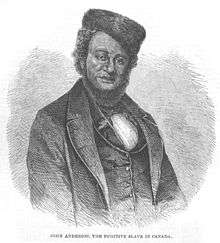Extradition case of John Anderson
The Anderson case took place in Canada West from 1860 to 1861. The case dealt with whether or not to extradite an escaped slave to the United States on the charge of murder. The majority of the presiding judges who handled the case agreed that there was sufficient evidence to prove criminality of the extraditable offence. The decision was based upon the terms laid out in Article X of the Webster–Ashburton Treaty of 1842. Anderson was released, however, on a technicality.
.jpg)
Background
John Anderson was an African-American slave who escaped to Canada, evading the pursuit of bounty hunters. While on the run he killed a farmer from Howard County, Missouri. Anderson stabbed the farmer, Seneca Digges, who died shortly after. Digges intended to legally recapture Anderson, and ultimately send him back into his master’s custody. Anderson lived and worked in Canada West from 1854 to April 1860, managing to keep a low profile. He was eventually arrested and held by Magistrate William Matthews in Brantford, Ontario.
Legal and political significance

Some have argued that the Anderson case, aside from igniting a media, legal, and political frenzy, had a profound impact on Canada’s future relationship with Britain (Brode 1989, Farwell 1912, Reinders 1975). It also set an important precedent for Canadian leaders to make the superior courts handle the most political divisive decisions, which had originally been reserved for the executive branch of government.[2] John Anderson's motive for escape arose following his sale to another farmer. He realized he would never see his family again in such a situation, and this was unbearable. He hoped to become a legitimate free man and work so he could earn enough money to purchase his family out of bondage. Escape to Canada became his only option after he allegedly killed Missouri farmer Seneca Digges "by accident" when an attempt on his capture was made by Digges. When Anderson got to Canada there were wanted posters everywhere. The Canadian citizenry and the government at the time engaged in heated debate over whether it was acceptable for Anderson to live free in their country. Some people thought that he was dangerous and might end up killing Canadian farmers. Others denied feeling any threat of danger from the man, and argued for him to stay.
Assistance
Anti-slavery associations from Britain and pre-Confederation Canada played an instrumental role in assisting Anderson before, during, and after the case. Sir John A. Macdonald, made use of public funds to foot the bill for Anderson’s legal defences.[3]
Britain attempts to intervene
A crucial feature in the whole situation occurred while Anderson was awaiting an appeal of the Canadian court’s initial decision, which stipulated that he should indeed be extradited. The British Court of Queen’s Bench attempted to interfere by sending a writ of habeas corpus for him to appear before a court in London, England, to Britain's Canadian subjects who were already in the process of handling the situation. "Not only was the writ ‘an evil precedent’, but it could lead to further conflict between English and Canadian judicatures."[4] The English courts never got their chance to handle the case because Anderson’s appeal was expedited to the Court of Common Pleas. He was released due to faulty wording in the warrant.
Reactions
The issue with the English writ, and the negative reaction to it, uncovered the need for written clarification of the relationship between English and Canadian courts. As one result, the Habeas Corpus Act 1862 was passed by the Parliament of the United Kingdom in 1862, which denied British courts the right to issue writs of habeas corpus for British colonies or dominions with their own courts capable of doing so. It reaffirmed that Canadian jurisdictions had become self-sufficient and did not take kindly to interferences in their judicial system.[5] It is a significant case to study in Canada’s legal, political, and social heritage.
References
- Harper Twelvetrees, John Anderson (1863) The Story of the Life of John Anderson, William Tweedie, London (Google eBook)
- Patrick Brode (1989), The Odyssey of John Anderson, pp. 107–108, The Osgoode Society, Toronto.
- J. K. Johnson and Carole B. Stelmack, eds (1969) Papers of the Prime Ministers: Volume II; The Letters of Sir John A. Macdonald 1858–1861, p. 357, Public Archives of Canada, Ottawa.
- Robert C. Reinders, "The John Anderson Case, 1860–1, A Study in Anglo-Canadian Imperial Relations" (1975), The Canadian Historical Review, Vol. 56:4 p. 407, University of Toronto Press, Toronto.
- Brode (1989), p. 118.